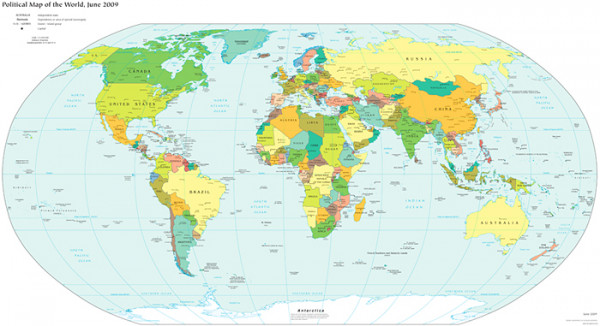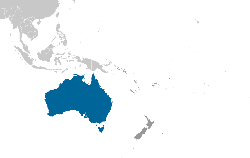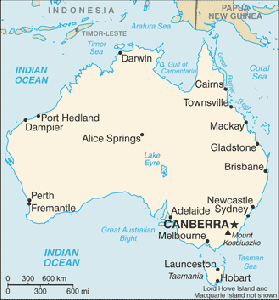Australia: The land "Down Under"
The term "Down Under" comes from the fact that Australia is located in the southern hemispherehalf of the Earth, below many other countries on the globe.
Overview
| Flag |
|
| Anthem |
Advance Australia Fair
Watch on youtube (with lyrics)
|
| Capital |
Canberra |
| Largest city |
Sydney |
| National language |
English (de facto) |
| Government |
Federal parliamentary democracy and constitutional monarchy |
| Area |
1,7,617,930 km2, 2,941,299 sq mi |
| Population |
~ 22 million |
| Currency |
Australian dollar (AUD) |
| Internet TLD |
.au |
Geography
Australia, officially the Commonwealth of Australia, is a country in the Southern
Hemispherehalf of the Earth comprising the mainland of the Australian continent (the world's smallest), the island of Tasmania, and numerous smaller islands in the Indian and Pacific Oceans. Neighbouring countries include Indonesia, East Timor, and Papua New Guinea to the north, the Solomon Islands, Vanuatu, and New Caledonia to the northeast, and New Zealand to the southeast. Australia has six states—New South Wales, Queensland, South Australia, Tasmania, Victoria, and Western Australia—and two major mainland
territoriesa geographic area under control of a single governing entity such as state or municipality—the Northern Territory and the Australian Capital Territory (ACT).
The capital city of Australia is Canberra. With a population of over 345,000, it is Australia's largest inland city and the eighth largest Australian city overall. The largest city in Australia and Oceania is Sydney with a population of 4,504,469. It is also the state capital of New South Wales, and is located on Australia's south-east coast of the Tasman Sea. Other large cities are the mainland state capitals: Sydney, Melbourne, Brisbane, Perth and Adelaide.
Society and culture
Since 1788, the primary basis of Australian culture has been Anglo-Celtic Western culture.
Distinctivethat is characteristic or typical of something cultural features have also
arisento start to exist from Australia's natural environment and
Indigenousnative to a land or region cultures. Since the mid-20th century, American popular culture has strongly influenced Australia, particularly through television and cinema. Other cultural influences come from neighbouring Asian countries, and through
large-scalelarge in amount, scope or extent immigration from non-English-speaking nations.
Population
Most of the estimated 22 million Australians are
descendedto come down, as from a source, original, or stock; to be derived; to proceed by generation from colonial-era
settlerssomeone who settles in a new location, especially one who makes a previously uninhabited place his home and immigrants from Europe, with almost 90% of the population being of European descent. For generations, the
vastvery great in size, amount, degree, intensity, or especially extent majority of immigrants came from the British Isles, and the people of Australia are still mainly of British or Irish ethnic origin. In the 2006 Australian
Censusan official count of members of a population, the most commonly nominated
ancestryancestral lineage; hence, birth or honourable descent was Australian (37.13%), followed by English (31.65%), Irish (9.08%), Scottish (7.56%), Italian (4.29%), German (4.09%), Chinese (3.37%), and Greek (1.84%).
Languages
English is the national language. Australian English has a
uniquebeing the only one of its kind accent and a small number of unique
termsa word or phrase, especially one from a specialised area of knowledge, some of which have found their way into other
dialectsa variety of a language that is characteristic of a particular area, community or group of the English-speaking world. Grammar and spelling are largely based on those of British English. According to the 2006 Census, English is the only language spoken at home for close to 79% of the population. The next most common languages spoken at home are Italian (1.6%), Greek (1.3%) and Cantonese (1.2%).
Religion
Australia has no state religion. In the 2006 Census, 64% of Australians listed themselves as Christian, including 26% as Roman Catholic and 19% as Anglican. The second-largest religion in Australia is Buddhism (2.1%), followed by Islam (1.7%), Hinduism (0.8%), and Judaism (0.5%). Overall, fewer than 6% of Australians identify with non-Christian religions. About 19% of the population cited "No religion", and a further 12% did not answer (the question is optional). Religion does not play a central role in the lives of much of the population, although young adults are somewhat more religious than their
eldersan older person.
Government and politics
The Commonwealth of Australia is a constitutional
democracyrule by the people, especially as a form of government; either directly or through elected representatives based on a federal
divisionseparation of powers. The form of government used in Australia is a constitutional
monarchya government with a hereditary head of state with a parliamentary system of government. Queen Elizabeth II is the Queen of Australia. There are three branches of government: the
legislaturea governmental body with the power to make, amend and repeal laws (the Commonwealth Parliament, comprising the Queen, the Senate, and the House of Representatives), the
executiveresponsible for enforcing laws and judicial decisions, and for the day-to-day running of the state (the Federal Executive Council, the Prime Minister and Ministers of State) and the
judiciaryresponsible for maintaining the courts of law and for the administration of justice (the High Court of Australia and other federal courts).
Economy
Australia's per capita
GDPGross Domestic Product is slightly higher than that of the United States, United Kingdom, Germany, and France. All of Australia's major cities
fareto be, to succeed well in global
comparativeusing comparison as a method of study liveabilitythe property of being endurable, survivable, suitable for living in surveys. There has been an
emphasisa special attention or prominence given to something on exporting
commoditiesanything movable (a good) that is bought and sold rather than manufactured goods since the start of the century. The service sector of the economy, including tourism, education, and financial services, accounts for 69% of GDP. Although agriculture and
natural resourcesany source of wealth that occurs naturally, especially minerals, fossil fuels, etc. account for only 3% and 5% of GDP, they
contributeto give something, that is or becomes part of a larger whole substantially to export performance. Australia's largest export markets are Japan, China, the US, South Korea, and New Zealand.






